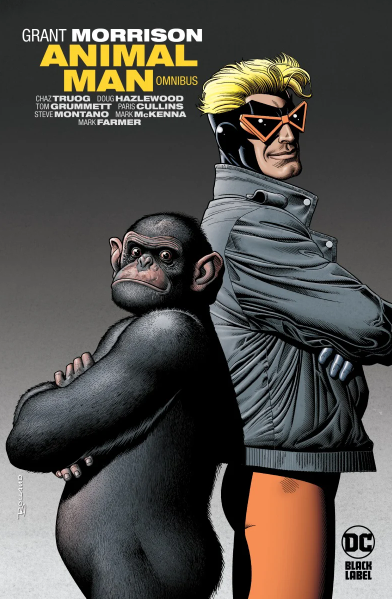
If the Coyote from the Ostrich Runner cartoon is crucified like Jesus Christ in the comic book card, know that Grant Morrison is lurking behind the corner. We can find such a scene in one of the stories about Animal Man. There are more peculiar visions there.
Animal Man is a superhero from the DC world who can take over the powers of the animals around him. When a squirrel is nearby, the hero will start jumping agilely on the trees. When he meets an elephant on his way, his power becomes unlimited. The character was created in 1965, but did not get its own series before 1989. In the 1980s, Animal Man made a major cameo on the Infinite Earth Crisis crossover, and then finally got a separate comic book. Grant Morrison became the author of the Animal Man stories in line with the policy of the DC stable at that time, which gave lesser-known characters to unconventional creators (Swamp Thing for Alan Moore and Sandman for Neil Gaiman). It was the first major series in the artistic path of the author, who later became known as the world's most amazing comic book writer (read more about Morrison here).
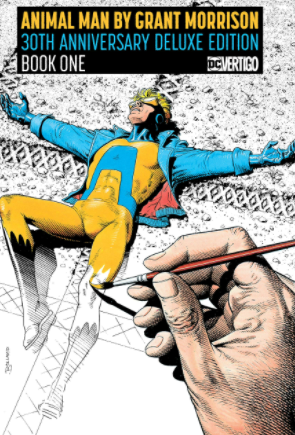
A large volume has just been released in Poland, focusing all the adventures of Animal Man under the baton of Grant Morrison. This is another beautiful edition of Egmont that can be placed on a shelf next to the Ancients or Batman Noir. The form of the comic (although impressive) is not the most important here. Finally, we have the opportunity to take a look at the artist's first comic books whose work had a huge impact on superhero aesthetics. On the threshold of his great career, was Grant Morrison as uncompromising as when he created Doom Patrol or The Invisibles? Was he already enjoying the benefits of his great imagination? We get the answer to this question after reading the first three comics in the series. Grant Morrison has created a work that on some levels can be compared with Alan Moore's Swamp Thing. It is primarily about the approach to the hero who has so far loomed in the background of the DC universe. Like Moore's Swamp Thing, Morrison's Animal Man became not so much a superhero, but a vehicle for an idea. However, this is where the similarities end, because where Alan Moore uses the language of poetry to formulate rules about the present day, Morrison prefers to show his worldview and have a meta-discussion with the reader. What's more, it was in Animal Mana that the author began a dance with the time continuum, which continues in his work to this day. But let's start from the beginning.
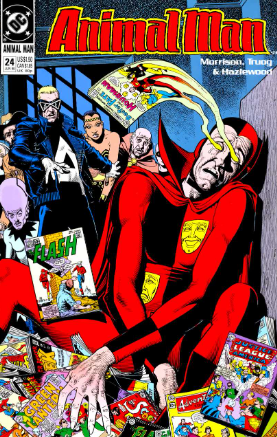
Animal Man's name is Buddy Baker, he has a wife, two children and a house in the suburbs. When she's not a superhero, she leads a perfectly normal life and struggles with a tedious everyday life. His hero career is developing quite well. He gets an invitation to the Justice League, and the next villains on his way fall defeated. Buddy is often involved in animal defense actions. Together with activists, he attacks laboratories where criminal experiments on pets are carried out. It helps to save dolphins from massacres, frees the humanoids suffering during criminal research. Seemingly, everything takes place in a rhythm characteristic of superhero stories. Somewhere in the middle of the comic, however, we find out that these are only appearances. Animal Man is a participant in a complex game played by: time, space and reality. Soon the hero's world falls apart, and he himself becomes a traveler through the continuum.
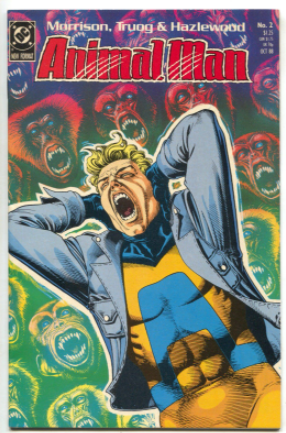
Some of Animal Man's adventures are procedural (they begin and end within one notebook), but most of them combine to form the main plot of the comic. So we have a story that runs throughout the story, adorned here and there with digressions (which also matter in general). Even though several of the stories focus on the fight between a superhero and a super villain, you won't find any classic comic book solutions here. Animal Man is steeped in the Morrison style that we know so well from his later works. Moreover, in the second half of the volume it is difficult to resist the impression that we are reading one of the most radical works of the author in terms of artistic uncompromisingness. Motifs such as (mentioned above) Coyote Wiluś constitute a kind of prelude to the author's deliberations on the role of art in the contemporary world. This is not the end, however. In the final story, the author himself appears, interacting with Animal Man and explaining the rules by which comics operate. For the first time, the theme of picture stories is also used as gates to parallel worlds. This idea was used in the later Multiverse.

Over time, the extraordinary powers of Animal Man fade to the sidelines, and play with reality comes to the fore. The farther into the forest, the more original and surreal the comic becomes. This has its advantages (one hundred percent Morrison in Morrison), but also disadvantages, because the character itself is not fully exploited. Fortunately, the comic book published by Egmont is so extensive that there is no question of any profession. There is room for time travel, as well as vegetarianism, animal protection, spiritualism and humorous threads. What's more, Morrison is very good at moral themes. The Baker family is a very nice bunch. You can like them, although the author at times plays perfidiously with our sentiments. In the second half of the volume, the artist allows himself a twist, which makes the hair stand out on his head.
As for the graphics, of course there are no fireworks here. The robe is characteristic of the picture tales of the 1980s. The later Doom Patrol, whose visual form was one of the narrative tools, was much better in this respect. In Animal Manie, the artwork certainly doesn't get in the way of following Morrison's increasingly crazier ideas, but it also doesn't make up any big deal of the release. Only the covers of Brian Bolland deserve attention, as they perfectly correspond to the writer's style and at times refer to his concept of the comic book world merging with the reality of the writer / reader.
Animal Man is another album released in Poland that every comic book connoisseur should have on his shelf. One that shows the beginnings of Grant Morrison as a giant of superhero aesthetics, and two that it is a piece of a great story that, after thirty years, is still exciting, touching and entertaining. Egmont rose to the occasion again - we ask for more classics of this wonderfully rendered!
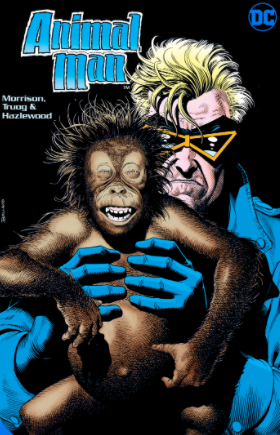
Upvoted 👌 (Mana: 0/47) Liquid rewards.